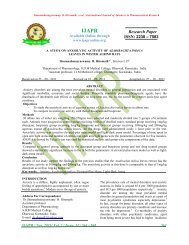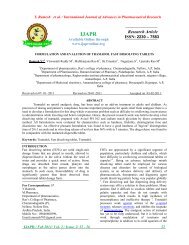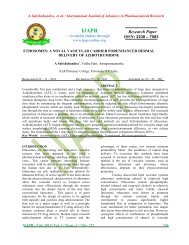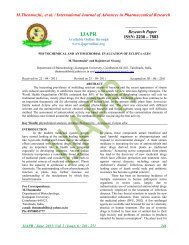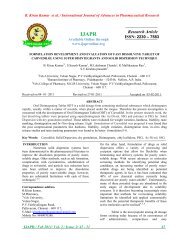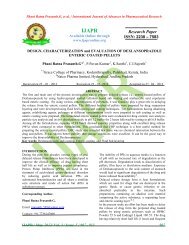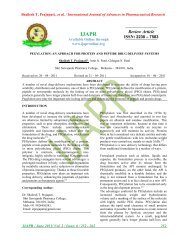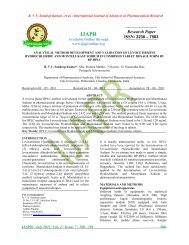pharmacological aspects of calotropis gigantea on various health ...
pharmacological aspects of calotropis gigantea on various health ...
pharmacological aspects of calotropis gigantea on various health ...
You also want an ePaper? Increase the reach of your titles
YUMPU automatically turns print PDFs into web optimized ePapers that Google loves.
Anurag Agrawal., et al. / Internati<strong>on</strong>al Journal <str<strong>on</strong>g>of</str<strong>on</strong>g> Advances in Pharmaceutical Research<br />
IJAPR<br />
Available Online through<br />
www.ijapr<strong>on</strong>line.org<br />
Review Article<br />
ISSN: 2230 – 7583<br />
PHARMACOLOGICAL ASPECTS OF CALOTROPIS GIGANTEA ON VARIOUS<br />
HEALTH PROBLEMS: A REVIEW<br />
Anurag Agrawal 1* , Namrata Singh 2 , Pushpendra Kannojia 3 , Virendra Kumar Garg 4<br />
1 R.C.Patel Institute <str<strong>on</strong>g>of</str<strong>on</strong>g> Pharmaceutical Educati<strong>on</strong> & Research, Near Karwand Naka, Shirpur Dhule -425405 (M.S.)<br />
2 Department <str<strong>on</strong>g>of</str<strong>on</strong>g> Pharmacy, Barkatullah University, Hoshangabad road, Bhopal- 462026 (M.P.)<br />
3<br />
IPS-College <str<strong>on</strong>g>of</str<strong>on</strong>g> Pharmacy, Bela Ki Bawadi Tiraha, Shivpuri Link Road Gwalior-474001(M.P.)<br />
4<br />
Gurukul Institute <str<strong>on</strong>g>of</str<strong>on</strong>g> Pharmaceutical Sciences & Research, Tighra Road Gwalior-474001(M.P.)<br />
Received <strong>on</strong> 27 – 09 - 2011 Revised <strong>on</strong> 20 – 10- 2011 Accepted <strong>on</strong> 20 – 11 – 20<br />
ABSTRACT<br />
Now days, research <strong>on</strong> medicinal plants has c<strong>on</strong>cerned a lot <str<strong>on</strong>g>of</str<strong>on</strong>g> attenti<strong>on</strong> globally. A number <str<strong>on</strong>g>of</str<strong>on</strong>g> c<strong>on</strong>firmati<strong>on</strong>s have<br />
been accumulated to express promising potential <str<strong>on</strong>g>of</str<strong>on</strong>g> medicinal plants used in <strong>various</strong> traditi<strong>on</strong>al, complementary and<br />
alternative systems. In recent years a medicinal plant, Calotropis <str<strong>on</strong>g>gigantea</str<strong>on</strong>g> and its major active c<strong>on</strong>stituents have<br />
been extensively studied for several <str<strong>on</strong>g>pharmacological</str<strong>on</strong>g> activities. Calotropis <str<strong>on</strong>g>gigantea</str<strong>on</strong>g> (Asclepiadacea) known as Arka<br />
is being used in traditi<strong>on</strong>al medicines and c<strong>on</strong>tains cardiac glycosides, alkaloids, flav<strong>on</strong>oids, tannins, reducing<br />
sugars etc. It has been found to have analgesic activity, antipyretic activity, pregnancy interceptive activity, CNS<br />
activity, anti-inflammatory activity, pro-coagulant activity, anti-diarrheal activity, free radical scavenging activity,<br />
antimicrobial activity, anti-tumor activity, antifungal activity, anti-tussive activity, antifeedent activity. To facilitate<br />
the readers to look at their areas <str<strong>on</strong>g>of</str<strong>on</strong>g> interest more easily, the informati<strong>on</strong> in the current review have been organised in<br />
<strong>various</strong> secti<strong>on</strong>s according to <str<strong>on</strong>g>pharmacological</str<strong>on</strong>g> <str<strong>on</strong>g>aspects</str<strong>on</strong>g> <str<strong>on</strong>g>of</str<strong>on</strong>g> the plant Calotropis <str<strong>on</strong>g>gigantea</str<strong>on</strong>g> <strong>on</strong> <strong>various</strong> <strong>health</strong> problems.<br />
Key Words: Analgesic, arka, <str<strong>on</strong>g>calotropis</str<strong>on</strong>g> <str<strong>on</strong>g>gigantea</str<strong>on</strong>g>, free radical scavenging activity, traditi<strong>on</strong>al medicines.<br />
INTRODUCTION<br />
Calotropis <str<strong>on</strong>g>gigantea</str<strong>on</strong>g> (Asclepiadaceae) is comm<strong>on</strong>ly<br />
known as Madar and wild growing tropical plant,<br />
which possesses number <str<strong>on</strong>g>of</str<strong>on</strong>g> medicinal properties.<br />
Humankind first utilized material found in<br />
envir<strong>on</strong>ment <strong>on</strong> an empirical basis to cure <strong>various</strong><br />
ailments. Natural products from plants and animals<br />
traditi<strong>on</strong>ally have provided the pharmaceutical<br />
industry with <strong>on</strong>e <str<strong>on</strong>g>of</str<strong>on</strong>g> its important sources <str<strong>on</strong>g>of</str<strong>on</strong>g> lead<br />
compounds in search <str<strong>on</strong>g>of</str<strong>on</strong>g> new drugs and medicines.<br />
The search for new <str<strong>on</strong>g>pharmacological</str<strong>on</strong>g>ly active agents<br />
from natural resources such as plants, animals and<br />
microbes led to discovery <str<strong>on</strong>g>of</str<strong>on</strong>g> many clinically useful<br />
drugs 1 .<br />
* For Corresp<strong>on</strong>dence:<br />
Anurag Agrawal<br />
Department Of Pharmacology<br />
R.C.Patel Institute Of Pharmaceutical Educati<strong>on</strong> &<br />
Research<br />
Near Karwand Naka, Shirpur, Dhule (M.S.)-425405<br />
E-Mail: anu2pharma@gmail.com<br />
Mob: +91-9685824456.<br />
It is reported to c<strong>on</strong>tain cardiac glycosides, -<br />
sitosterol, madrine, sap<strong>on</strong>ins, alkaloids, tannins,<br />
trisecharoides and flav<strong>on</strong>ols. The plant has been used<br />
for <strong>various</strong> disease c<strong>on</strong>diti<strong>on</strong>,including leprosy,<br />
ulcers, tumours and piles. Various <str<strong>on</strong>g>pharmacological</str<strong>on</strong>g><br />
activity reported like analgesic activity,anti-fertility,<br />
anti-inflammatory activity, hepato-protective activity,<br />
antimyocardial infracti<strong>on</strong> activity and antidirrhreal<br />
activity.<br />
PHARMACOLOGICAL ACTIVITIES<br />
1. Studies <strong>on</strong> anti-diarrhoeal activity <str<strong>on</strong>g>of</str<strong>on</strong>g><br />
Calotropis <str<strong>on</strong>g>gigantea</str<strong>on</strong>g> r.br. in experimental<br />
animals. The anti-diarrheal effect <str<strong>on</strong>g>of</str<strong>on</strong>g><br />
hydroalcoholic (50:50) extract <str<strong>on</strong>g>of</str<strong>on</strong>g> aerial part <str<strong>on</strong>g>of</str<strong>on</strong>g><br />
Calotropis <str<strong>on</strong>g>gigantea</str<strong>on</strong>g> was studied against castor<br />
oil-induced-diarrhea model in rats. The<br />
gastrointestinal transit rate was expressed as the<br />
percentage <str<strong>on</strong>g>of</str<strong>on</strong>g> the l<strong>on</strong>gest distance traversed by<br />
the charcoal divided by the total length <str<strong>on</strong>g>of</str<strong>on</strong>g> the<br />
small intestine. The weight and volume <str<strong>on</strong>g>of</str<strong>on</strong>g><br />
IJAPR / Dec. 2011/ Vol. 2 / Issue. 12 / 613 - 620 613
Anurag Agrawal., et al. / Internati<strong>on</strong>al Journal <str<strong>on</strong>g>of</str<strong>on</strong>g> Advances in Pharmaceutical Research<br />
intestinal c<strong>on</strong>tent induced by castor oil were<br />
studied by enteropooling method. 1<br />
2. Studies <strong>on</strong> proteinases from Calotropis<br />
<str<strong>on</strong>g>gigantea</str<strong>on</strong>g> latex. I. Purificati<strong>on</strong> and some<br />
properties <str<strong>on</strong>g>of</str<strong>on</strong>g> two proteinases c<strong>on</strong>taining<br />
carbohydrate. Two proteinase c<strong>on</strong>taining<br />
carbohydrate, called calotropain-FI and<br />
calotropain-FII, were purified from Calotropis<br />
<str<strong>on</strong>g>gigantea</str<strong>on</strong>g> latex by CM-Sephadex C-50<br />
chromatography. Both calotropain-FI and FII<br />
were found to be homogeneous by rechromatography<br />
<strong>on</strong> CM-Sephadex C-50, gel<br />
filtrati<strong>on</strong> <strong>on</strong> Sephadex G-100, electrophoresis <strong>on</strong><br />
polyacrylamide gel and by N-terminal amino<br />
acid analysis. Some properties <str<strong>on</strong>g>of</str<strong>on</strong>g> these enzymes<br />
are reported. 2<br />
3. Comparative studies <strong>on</strong> calotropins DI and DII<br />
from the latex <str<strong>on</strong>g>of</str<strong>on</strong>g> Calotropis <str<strong>on</strong>g>gigantea</str<strong>on</strong>g>.<br />
Autodigesti<strong>on</strong> <str<strong>on</strong>g>of</str<strong>on</strong>g> two cysteine proteinases,<br />
calotropins DI and DII isolated from the latex <str<strong>on</strong>g>of</str<strong>on</strong>g><br />
Calotropis <str<strong>on</strong>g>gigantea</str<strong>on</strong>g>, has been studied at pH 7.5 and<br />
37 degrees C in the presence <str<strong>on</strong>g>of</str<strong>on</strong>g> an activating agent.<br />
Calotropin DI is more susceptible to autodigesti<strong>on</strong><br />
than calotropin DII. During autodigesti<strong>on</strong> no<br />
interc<strong>on</strong>versi<strong>on</strong> <str<strong>on</strong>g>of</str<strong>on</strong>g> <strong>on</strong>e calotropin to another has<br />
occurred, as verified by polyacrylamide gel<br />
electrophoresis in the presence and absence <str<strong>on</strong>g>of</str<strong>on</strong>g><br />
sodium dodecyl sulfate. Immunologically, both<br />
calotropins are closely related, but they differ from<br />
papain and ficin. Both calotropins block N-terminal<br />
amino acid residues. 3<br />
4. Studies <strong>on</strong> proteinases from Calotropis<br />
<str<strong>on</strong>g>gigantea</str<strong>on</strong>g> latex. II. Physico-chemichal<br />
properties <str<strong>on</strong>g>of</str<strong>on</strong>g> calotropain-FI and FII. The<br />
molecular weights <str<strong>on</strong>g>of</str<strong>on</strong>g> purified calotropain-FI and<br />
FII were determined by sodium dodecyl<br />
sulphate-polyacrylamide gel electrophoresis and<br />
by filtrati<strong>on</strong> <str<strong>on</strong>g>of</str<strong>on</strong>g> Sephadex G-100. Activati<strong>on</strong> <str<strong>on</strong>g>of</str<strong>on</strong>g><br />
calotropain-FI and FII by different sulfhydryl<br />
activators was studied. The results obtained from<br />
inhibiti<strong>on</strong> studies by <strong>various</strong> enzyme-modifying<br />
reagents suggest the possible role <str<strong>on</strong>g>of</str<strong>on</strong>g> cysteine and<br />
histidine residues in the active site <str<strong>on</strong>g>of</str<strong>on</strong>g> both the<br />
enzymes. The free and total sulfhydryl c<strong>on</strong>tents<br />
<str<strong>on</strong>g>of</str<strong>on</strong>g> both the enzymes were determined by the use<br />
<str<strong>on</strong>g>of</str<strong>on</strong>g> 5-5'-dithio-bis-2-nitrobenzoic acid. Total<br />
amino acid compositi<strong>on</strong>s <str<strong>on</strong>g>of</str<strong>on</strong>g> both the enzymes<br />
were also determined. A comparative study <str<strong>on</strong>g>of</str<strong>on</strong>g><br />
the esterase, amidase, milk-clotting and<br />
caseinolytic activities <str<strong>on</strong>g>of</str<strong>on</strong>g> calotropain-FI and FII<br />
are also presented. 4<br />
5. Evaluati<strong>on</strong> <str<strong>on</strong>g>of</str<strong>on</strong>g> antipyretic activity <str<strong>on</strong>g>of</str<strong>on</strong>g> Calotropis<br />
<str<strong>on</strong>g>gigantea</str<strong>on</strong>g> (Asclepiadaceae) in experimental<br />
animals. The roots <str<strong>on</strong>g>of</str<strong>on</strong>g> Calotropis <str<strong>on</strong>g>gigantea</str<strong>on</strong>g> have<br />
been used in leprosy, eczema, syphilis,<br />
elephantiasis, ulcerati<strong>on</strong> and cough in the Indian<br />
system <str<strong>on</strong>g>of</str<strong>on</strong>g> traditi<strong>on</strong>al medicine. The present<br />
review reveals its antipyretic activity by using<br />
yeast-induced and TAB (Typhoid) vaccineinduced<br />
pyrexia in rats and rabbits. In both yeastinduced<br />
and TAB vaccine-induced fever, the<br />
fever was significantly reduced and the body<br />
temperature was normalized by administrati<strong>on</strong> <str<strong>on</strong>g>of</str<strong>on</strong>g><br />
200 and 400 mg/kg dose <str<strong>on</strong>g>of</str<strong>on</strong>g> Calotropis <str<strong>on</strong>g>gigantea</str<strong>on</strong>g><br />
extract intraperit<strong>on</strong>eally. Based <strong>on</strong> the results <str<strong>on</strong>g>of</str<strong>on</strong>g><br />
the present study it can be c<strong>on</strong>cluded that the<br />
extract <str<strong>on</strong>g>of</str<strong>on</strong>g> C.<str<strong>on</strong>g>gigantea</str<strong>on</strong>g> has potential antipyretic<br />
activity against both yeast-induced and TAB<br />
vaccine-induced fever, indicating the possibility<br />
<str<strong>on</strong>g>of</str<strong>on</strong>g> developing C.<str<strong>on</strong>g>gigantea</str<strong>on</strong>g> as a cheaper and potent<br />
antipyretic agent. 5<br />
6. Procoagulant activity <str<strong>on</strong>g>of</str<strong>on</strong>g> Calotropis <str<strong>on</strong>g>gigantea</str<strong>on</strong>g><br />
latex associated with fibrin(ogen)olytic<br />
activity. The crude latex extract c<strong>on</strong>tained many<br />
proteins, which are highly basic in nature and<br />
exhibited str<strong>on</strong>g proteolytic activity. The crude<br />
extract hydrolyses casein, human fibrinogen and<br />
crude fibrin clot in a dose-dependent manner.<br />
The hydrolyzing activity was completely<br />
inhibited by IAA indicating that they bel<strong>on</strong>g to<br />
the super family, cysteine proteases. Crude<br />
extract hydrolyses Alpha, Beta and gamma<br />
subunits <str<strong>on</strong>g>of</str<strong>on</strong>g> fibrinogen. Am<strong>on</strong>g all the subunits<br />
the preferential subunit to get hydrolyzed was<br />
Alpha followed by Beta and gamma subunit is<br />
highly resistant and hydrolyzed at higher protein<br />
c<strong>on</strong>centrati<strong>on</strong> or over a prol<strong>on</strong>ged incubati<strong>on</strong><br />
time. The crude extract hydrolysis crude fibrin<br />
clot str<strong>on</strong>gly compared to trypsin and papain.<br />
Pharmacologically the crude extract is<br />
hemorrhagic and induces skin hemorrhage at >75<br />
microgram and reduces coagulati<strong>on</strong> time <str<strong>on</strong>g>of</str<strong>on</strong>g><br />
citrated plasma from 150 to 47 s and promotes<br />
blood coagulati<strong>on</strong>. 6<br />
7. Pregnancy interceptive activity <str<strong>on</strong>g>of</str<strong>on</strong>g> the roots <str<strong>on</strong>g>of</str<strong>on</strong>g><br />
Calotropis <str<strong>on</strong>g>gigantea</str<strong>on</strong>g> Linn. in rats. The ethanolic<br />
extract <str<strong>on</strong>g>of</str<strong>on</strong>g> the roots <str<strong>on</strong>g>of</str<strong>on</strong>g> C.<str<strong>on</strong>g>gigantea</str<strong>on</strong>g> Linn. exhibited<br />
100% pregnancy interceptive activity in rats<br />
when administered as a single oral dose <str<strong>on</strong>g>of</str<strong>on</strong>g> 100<br />
mg/kg <strong>on</strong> Day 1 postcoitum. The extract also<br />
exhibited 100% efficacy at the dose <str<strong>on</strong>g>of</str<strong>on</strong>g> 12.5<br />
mg/kg when administered in the Days 1-5 and 1-<br />
7 postcoitum schedules. When C.<str<strong>on</strong>g>gigantea</str<strong>on</strong>g> Linn.<br />
was administered during the peri-cum-early post<br />
implantati<strong>on</strong> period (i.e., Days 5-7 postcoitum at<br />
250 mg/kg), most <str<strong>on</strong>g>of</str<strong>on</strong>g> the implantati<strong>on</strong>s showed<br />
signs <str<strong>on</strong>g>of</str<strong>on</strong>g> resorpti<strong>on</strong>. On fracti<strong>on</strong>ati<strong>on</strong>, the<br />
chlor<str<strong>on</strong>g>of</str<strong>on</strong>g>orm fracti<strong>on</strong> showed 100% activity at 100<br />
mg/kg in the single-day (Day 1 postcoitum)<br />
schedule, whereas the hexane, n-butanol-soluble<br />
and n-butanol-insoluble fracti<strong>on</strong>s were found to<br />
be inactive at this dose. At autopsy <strong>on</strong> Day 10<br />
IJAPR / Dec. 2011/ Vol. 2 / Issue. 12 / 613 - 620 614
Anurag Agrawal., et al. / Internati<strong>on</strong>al Journal <str<strong>on</strong>g>of</str<strong>on</strong>g> Advances in Pharmaceutical Research<br />
postcoitum, 7-25% loss in body weight was<br />
recorded at the minimum effective c<strong>on</strong>traceptive<br />
dose (MED) in rats treated with the ethanolic<br />
extract as well as its chlor<str<strong>on</strong>g>of</str<strong>on</strong>g>orm-soluble fracti<strong>on</strong><br />
<strong>on</strong> Days 1-7, 1-5 and 1 postcoitum, in<br />
comparis<strong>on</strong> with the 6-7% increase in body<br />
weight observed in vehicle c<strong>on</strong>trol rats. There<br />
was however no mortality in any <str<strong>on</strong>g>of</str<strong>on</strong>g> the treatment<br />
groups. The active ethanolic extract and its<br />
chlor<str<strong>on</strong>g>of</str<strong>on</strong>g>orm fracti<strong>on</strong> were devoid <str<strong>on</strong>g>of</str<strong>on</strong>g> any estrogen<br />
ag<strong>on</strong>istic or antag<strong>on</strong>istic activity at their<br />
respective MEDs in the ovariectomized<br />
immature rat bioassay. 7<br />
8. Phytoremediati<strong>on</strong> <str<strong>on</strong>g>of</str<strong>on</strong>g> radiostr<strong>on</strong>tium 90 (Sr)<br />
and radiocesium 137 (Cs) using giant milky<br />
weed (Calotropis <str<strong>on</strong>g>gigantea</str<strong>on</strong>g> R.Br.) plants.<br />
Potential <str<strong>on</strong>g>of</str<strong>on</strong>g> plants to remove radio nuclides/toxic<br />
elements from soils and soluti<strong>on</strong>s can be<br />
successfully applied for removal <str<strong>on</strong>g>of</str<strong>on</strong>g> important<br />
radio nuclides such as str<strong>on</strong>tium-90 ((90)Sr) and<br />
cesium-137 ((137)Cs). When uptake <str<strong>on</strong>g>of</str<strong>on</strong>g> (137)Cs<br />
and (90)Sr by Calotropis <str<strong>on</strong>g>gigantea</str<strong>on</strong>g> plants<br />
incubated in distilled water spiked with the<br />
radi<strong>on</strong>uclides either al<strong>on</strong>e or in combinati<strong>on</strong> was<br />
studied, it was found to have a high efficiency<br />
for the removal <str<strong>on</strong>g>of</str<strong>on</strong>g> (90) Sr, with 90% being<br />
removed from soluti<strong>on</strong>s (5x10(3)kBql(-1))<br />
within 24h <str<strong>on</strong>g>of</str<strong>on</strong>g> incubati<strong>on</strong>. However, in case <str<strong>on</strong>g>of</str<strong>on</strong>g><br />
(137) Cs, about 44% could be removed from<br />
soluti<strong>on</strong>s (5x10(3)kBql(-1)) at the end <str<strong>on</strong>g>of</str<strong>on</strong>g> 168h <str<strong>on</strong>g>of</str<strong>on</strong>g><br />
incubati<strong>on</strong>. Accumulati<strong>on</strong> <str<strong>on</strong>g>of</str<strong>on</strong>g> (90)Sr and (137)Cs<br />
was higher in roots compared to shoots. The<br />
plants could remediate both (90)Sr and (137)Cs<br />
when they were added together to the soluti<strong>on</strong>.<br />
When two m<strong>on</strong>ths old plants were incubated in<br />
low level nuclear waste, 99% <str<strong>on</strong>g>of</str<strong>on</strong>g> activity<br />
disappeared at the end <str<strong>on</strong>g>of</str<strong>on</strong>g> 15 days. The present<br />
study suggests that C. <str<strong>on</strong>g>gigantea</str<strong>on</strong>g> could be used as<br />
a potential candidate plant for phytoremediati<strong>on</strong><br />
<str<strong>on</strong>g>of</str<strong>on</strong>g> (90)Sr and (137)Cs. 8<br />
9. Flav<strong>on</strong>ol glycosides from Calotropis <str<strong>on</strong>g>gigantea</str<strong>on</strong>g>.<br />
Besides isolati<strong>on</strong> and characterizati<strong>on</strong> <str<strong>on</strong>g>of</str<strong>on</strong>g><br />
isorhamnetin-3-O-rutinoside, isorhamnetin-3-Oglucopyranoside<br />
and taraxasteryl acetate, a new<br />
flav<strong>on</strong>ol trisaccharide was isolated from the<br />
aerial parts <str<strong>on</strong>g>of</str<strong>on</strong>g> Calotropis <str<strong>on</strong>g>gigantea</str<strong>on</strong>g>, and its<br />
structure was established as isorhamnetin-3-O-<br />
[2-O-beta-D-galactopyranosyl-6-O-alpha-Lrhamnopy<br />
ranosyl]- beta-D-glucopyranoside by a<br />
combinati<strong>on</strong> <str<strong>on</strong>g>of</str<strong>on</strong>g> fast atom bombardment mass<br />
spectroscopy, 1H and 13C NMR spectra and<br />
some chemical degradati<strong>on</strong>s. 9<br />
10. Ind<strong>on</strong>esian medicinal plants. I. Chemical<br />
structures <str<strong>on</strong>g>of</str<strong>on</strong>g> calotroposides A and B, two new<br />
oxypregnane-oligoglycosides from the root <str<strong>on</strong>g>of</str<strong>on</strong>g><br />
Calotropis <str<strong>on</strong>g>gigantea</str<strong>on</strong>g> (Asclepiadaceae). Two new<br />
oxypregnane-oligoglycosides<br />
named<br />
calotroposides A (1) and B (2) have been<br />
isolated from the root <str<strong>on</strong>g>of</str<strong>on</strong>g> Calotropis <str<strong>on</strong>g>gigantea</str<strong>on</strong>g><br />
(Asclepiadaceae), an Ind<strong>on</strong>esian medicinal plant,<br />
and their chemical structures have been<br />
elucidated by chemical and spectroscopic<br />
methods as 12-O-benzoyllineol<strong>on</strong> 3-O-beta-Dcymaropyranosyl(1----4)-beta-Doleandropyranosyl(<br />
1----4)- beta-Doleandropyranosyl(1----4)-beta-Dcymaropyranosyl(1----4)-beta-Dcymaropyranoside<br />
and 12-Obenzoyldeacetylmetaplexigenin<br />
3-O-beta-Dcymaropyranosyl(1---4)-beta-Doleandropyranosyl(-<br />
---4)- beta-Doleandropyranosyl(1----4)-beta-Dcymaropyranosyl(1---<br />
-4)- beta-Dcymaropyranoside,<br />
respectively. 10<br />
11. A Novel Insect Antifeedant N<strong>on</strong>protein<br />
Amino Acid from Calotropis <str<strong>on</strong>g>gigantea</str<strong>on</strong>g>:<br />
Giganticine (1), a novel n<strong>on</strong>protein amino acid,<br />
has been isolated from a methanol extract <str<strong>on</strong>g>of</str<strong>on</strong>g> the<br />
root bark <str<strong>on</strong>g>of</str<strong>on</strong>g> Calotropis <str<strong>on</strong>g>gigantea</str<strong>on</strong>g> and its structure<br />
established by spectroscopic methods. It<br />
exhibited a significant antifeedant activity<br />
against nymphs <str<strong>on</strong>g>of</str<strong>on</strong>g> the desert locust Schistocerca<br />
gregaria. 11<br />
12. Cytotoxic principles <str<strong>on</strong>g>of</str<strong>on</strong>g> a Bangladeshi crude<br />
drug, ak<strong>on</strong>d mul (roots <str<strong>on</strong>g>of</str<strong>on</strong>g> Calotropis <str<strong>on</strong>g>gigantea</str<strong>on</strong>g><br />
L.). Three cardenolide glycosides, calotropin (1),<br />
frugoside (2), and 4'-O-beta-Dglucopyranosylfrugoside<br />
(3), were obtained as<br />
the cytotoxic principles <str<strong>on</strong>g>of</str<strong>on</strong>g> "ak<strong>on</strong>d mul" (roots <str<strong>on</strong>g>of</str<strong>on</strong>g><br />
Calotropis <str<strong>on</strong>g>gigantea</str<strong>on</strong>g> L.). The cytotoxicity <str<strong>on</strong>g>of</str<strong>on</strong>g><br />
these compounds against <strong>various</strong> cell lines <str<strong>on</strong>g>of</str<strong>on</strong>g><br />
human and mouse origin was tested. They<br />
showed similar cell line selectivity to those <str<strong>on</strong>g>of</str<strong>on</strong>g><br />
cardiac glycosides such as digoxin and ouabain:<br />
they are toxic to cell lines <str<strong>on</strong>g>of</str<strong>on</strong>g> human origin, but<br />
not to those derived from mouse origin at 2 µ/ml.<br />
12<br />
13. CNS activity <str<strong>on</strong>g>of</str<strong>on</strong>g> Calotropis <str<strong>on</strong>g>gigantea</str<strong>on</strong>g> roots.<br />
Alcoholic extract <str<strong>on</strong>g>of</str<strong>on</strong>g> peeled roots <str<strong>on</strong>g>of</str<strong>on</strong>g> Calotropis<br />
<str<strong>on</strong>g>gigantea</str<strong>on</strong>g>n (Asclepiadaceae) was tested orally in<br />
albino rats at the dose level <str<strong>on</strong>g>of</str<strong>on</strong>g> 250 and 500mg/kg<br />
bodyweight for CNS activity. Prominent<br />
analgesic activity was observed in Eddy's hot<br />
plate method and acetic acid induced writhing.<br />
The paw licking time was delayed and the<br />
numbers <str<strong>on</strong>g>of</str<strong>on</strong>g> writhings were greatly reduced.<br />
Significant antic<strong>on</strong>vulsant activity was seen as<br />
there was a delay in the <strong>on</strong>set <str<strong>on</strong>g>of</str<strong>on</strong>g><br />
pentylenetetrazole induced c<strong>on</strong>vulsi<strong>on</strong>s as well<br />
as decrease in its severity. The extract treated<br />
rats spent more time in the open arm <str<strong>on</strong>g>of</str<strong>on</strong>g> EPM<br />
showing its antianxiety activity. There was a<br />
IJAPR / Dec. 2011/ Vol. 2 / Issue. 12 / 613 - 620 615
Anurag Agrawal., et al. / Internati<strong>on</strong>al Journal <str<strong>on</strong>g>of</str<strong>on</strong>g> Advances in Pharmaceutical Research<br />
decrease in the locomotor activity. The fall <str<strong>on</strong>g>of</str<strong>on</strong>g>f<br />
time (motor coordinati<strong>on</strong>) was also decreased. A<br />
potentiati<strong>on</strong> in the pentobarbit<strong>on</strong>e-induced sleep<br />
due to the sedative effect <str<strong>on</strong>g>of</str<strong>on</strong>g> the extract was<br />
observed. No mortality was seen upto the dose <str<strong>on</strong>g>of</str<strong>on</strong>g><br />
1g/kg. These results show the analgesic,<br />
antic<strong>on</strong>vulsant, anxiolytic and sedative effect <str<strong>on</strong>g>of</str<strong>on</strong>g><br />
the extract. 13<br />
14. 19-Nor- and 18, 20-Epoxy-cardenolides from<br />
the Leaves <str<strong>on</strong>g>of</str<strong>on</strong>g> Calotropis <str<strong>on</strong>g>gigantea</str<strong>on</strong>g>. Two new<br />
cardenolides (1 and 2) al<strong>on</strong>g with 12 known<br />
compounds were isolated from the<br />
dichloromethane extract <str<strong>on</strong>g>of</str<strong>on</strong>g> the leaves <str<strong>on</strong>g>of</str<strong>on</strong>g><br />
Calotropis <str<strong>on</strong>g>gigantea</str<strong>on</strong>g>. The structural elucidati<strong>on</strong><br />
was accomplished by spectroscopic methods.<br />
Some <str<strong>on</strong>g>of</str<strong>on</strong>g> the isolates were evaluated for cytotoxic<br />
activity against KB, BC, and NCI-H187 cancer<br />
cell lines, and all cardenolides tested were found<br />
to possess str<strong>on</strong>g inhibitory effects. The presence<br />
<str<strong>on</strong>g>of</str<strong>on</strong>g> a deoxysugar at C-3, a formyl group at C-10,<br />
and an alpha,beta-unsaturated gamma-lact<strong>on</strong>e<br />
was crucial for cytotoxic activity. 14<br />
15. Analgesic activity <str<strong>on</strong>g>of</str<strong>on</strong>g> Calotropis <str<strong>on</strong>g>gigantea</str<strong>on</strong>g><br />
flower. The alcoholic extract <str<strong>on</strong>g>of</str<strong>on</strong>g> the flowers <str<strong>on</strong>g>of</str<strong>on</strong>g><br />
Calotropis <str<strong>on</strong>g>gigantea</str<strong>on</strong>g> was administered orally and<br />
explored for its analgesic activity in chemical<br />
and thermal models in mice. In acetic acid<br />
induced writhing test, an inhibiti<strong>on</strong> <str<strong>on</strong>g>of</str<strong>on</strong>g> 20.97%<br />
and 43.0% in the number <str<strong>on</strong>g>of</str<strong>on</strong>g> writhes was<br />
observed at the doses <str<strong>on</strong>g>of</str<strong>on</strong>g> 250 and 500 mg/kg,<br />
respectively. In the hot plate method the paw<br />
licking time was delayed. The analgesic effect<br />
was observed after 30 min <str<strong>on</strong>g>of</str<strong>on</strong>g> dose administrati<strong>on</strong><br />
which reached its maximum after 90 min. 15<br />
16. Evaluati<strong>on</strong> <str<strong>on</strong>g>of</str<strong>on</strong>g> anti-inflammatory activity <str<strong>on</strong>g>of</str<strong>on</strong>g><br />
Calotropis <str<strong>on</strong>g>gigantea</str<strong>on</strong>g> in <strong>various</strong> biological<br />
systems. The anti-inflammatory activity was<br />
evaluated using carrageenin-induced, kaolin -<br />
induced rat paw oedema for acute inflammati<strong>on</strong><br />
and cott<strong>on</strong>-pellet granuloma, adjuvant-induced<br />
arthritis model for chr<strong>on</strong>ic inflammati<strong>on</strong>.<br />
Antipyretic activity was carried out using yeast<br />
induced pyresis method. Phenylquin<strong>on</strong>e--<br />
induced writhing method in mice was also used<br />
for evaluati<strong>on</strong> <str<strong>on</strong>g>of</str<strong>on</strong>g> analgesic activity. Test<br />
compounds exhibited variable anti-inflammatory<br />
activity and peak activity <str<strong>on</strong>g>of</str<strong>on</strong>g> the test compounds<br />
were reached at 2 h. Alkaloid fracti<strong>on</strong> possesses<br />
comparatively high initial anti-inflammatory<br />
activity. The residual anti-inflammatory activity<br />
<str<strong>on</strong>g>of</str<strong>on</strong>g> alkaloid fracti<strong>on</strong> <str<strong>on</strong>g>of</str<strong>on</strong>g> Calotropis <str<strong>on</strong>g>gigantea</str<strong>on</strong>g><br />
suggest either a greater protein binding nature <str<strong>on</strong>g>of</str<strong>on</strong>g><br />
the compound there by providing a slow released<br />
pool <str<strong>on</strong>g>of</str<strong>on</strong>g> active drug molecule in the system or<br />
n<strong>on</strong> available <str<strong>on</strong>g>of</str<strong>on</strong>g> possible bioactive metabolites to<br />
retain the activity pr<str<strong>on</strong>g>of</str<strong>on</strong>g>ile relati<strong>on</strong>. Evaluati<strong>on</strong> <str<strong>on</strong>g>of</str<strong>on</strong>g><br />
the effect <str<strong>on</strong>g>of</str<strong>on</strong>g> Calotropis gingantea in <strong>various</strong><br />
experimental animal models. The antiinflammatory<br />
activity was evaluated using<br />
carrageenin-induced, kaolin-induced rat paw<br />
oedema for acute and cott<strong>on</strong>-pellet granuloma,<br />
adjuvant-induced arthritis model for chr<strong>on</strong>ic<br />
inflammati<strong>on</strong>. Antipyretic activity was carried<br />
out using yeast induced pyresis method. 16<br />
17. Heavy metal and nutrient c<strong>on</strong>centrati<strong>on</strong> in<br />
soil and plants growing <strong>on</strong> a metalliferous<br />
chromite minespoil: Metal c<strong>on</strong>taminati<strong>on</strong> in<br />
soil and plant samples from a chromite mine and<br />
its adjoining regi<strong>on</strong>s was determined. The metal<br />
c<strong>on</strong>centrati<strong>on</strong> varied in stem, leaf and root <str<strong>on</strong>g>of</str<strong>on</strong>g><br />
different tree species. In the case <str<strong>on</strong>g>of</str<strong>on</strong>g> shrubs, the<br />
highest c<strong>on</strong>centrati<strong>on</strong> <str<strong>on</strong>g>of</str<strong>on</strong>g> ir<strong>on</strong> (18.5 mg kg(-1)<br />
was detected in the stem <str<strong>on</strong>g>of</str<strong>on</strong>g> Combretum<br />
roxburghii. The c<strong>on</strong>centrati<strong>on</strong> <str<strong>on</strong>g>of</str<strong>on</strong>g> aluminium<br />
varied from 1.8 - 5.3 mg kg(-1) dry weight,<br />
whereas the nickel c<strong>on</strong>tent was found to be the<br />
highest in the stem <str<strong>on</strong>g>of</str<strong>on</strong>g> Calotropis <str<strong>on</strong>g>gigantea</str<strong>on</strong>g>. In the<br />
case <str<strong>on</strong>g>of</str<strong>on</strong>g> herbs, chromium c<strong>on</strong>centrati<strong>on</strong> was<br />
highest (60.9 mg kg(-1) dry weight) in Evovulus<br />
alsenoides and the lowest (18.8 mg kg(-1) dry<br />
weight) in Andrographis paniculata. There was a<br />
significant correlati<strong>on</strong> observed between<br />
chromium in soil with the root <str<strong>on</strong>g>of</str<strong>on</strong>g> tree species<br />
like Lagerstroemia parviflora, Madhuca<br />
l<strong>on</strong>gifolia, Anogeissus latifolia and Haldina<br />
cordyfolia. Nickel in soil was significantly<br />
correlated with the stem and leaf <str<strong>on</strong>g>of</str<strong>on</strong>g> all the tree<br />
species except Chlroxyl<strong>on</strong> sweitenta. Ir<strong>on</strong> in soil<br />
showed correlati<strong>on</strong> with the stem and leaf <str<strong>on</strong>g>of</str<strong>on</strong>g><br />
Chloroxyl<strong>on</strong> sweitenia. Am<strong>on</strong>g the shrubs<br />
(Calotropis <str<strong>on</strong>g>gigantea</str<strong>on</strong>g>, Combretum roxburghii<br />
and Smilax zeylancia), chromium in soil showed<br />
a correlati<strong>on</strong> with the root. Nickel in soil was<br />
positively correlated with the stem and leaf <str<strong>on</strong>g>of</str<strong>on</strong>g><br />
Calotropis <str<strong>on</strong>g>gigantea</str<strong>on</strong>g> and Combretum roxburghii.<br />
Am<strong>on</strong>g the herbs, chromium in the whole plant<br />
<str<strong>on</strong>g>of</str<strong>on</strong>g> Evolvulus alsenoids, Solanum surattense and<br />
Phyllanthus fraternus showed significant positive<br />
correlati<strong>on</strong> with soil; nickel in Solanum<br />
surattense showed significant positive correlati<strong>on</strong><br />
with soil. The positive correlati<strong>on</strong> coefficient<br />
was observed between ir<strong>on</strong> in the whole plant<br />
and soil <strong>on</strong> Phyllanthus virgatus, Phyllanthus<br />
fraternus and Andrographis paniculata. The<br />
above informati<strong>on</strong> would be useful for the<br />
establishment <str<strong>on</strong>g>of</str<strong>on</strong>g> a vegetati<strong>on</strong> cover <strong>on</strong> the mine<br />
waste heaps. 17<br />
18. Comparative Study <strong>on</strong> Plant Latex Proteases<br />
and their Involvement in Hemostasis: A<br />
Special Emphasis <strong>on</strong> Clot Inducing and<br />
Dissolving Properties. In the present study we<br />
compared the clot inducing and dissolving<br />
IJAPR / Dec. 2011/ Vol. 2 / Issue. 12 / 613 - 620 616
Anurag Agrawal., et al. / Internati<strong>on</strong>al Journal <str<strong>on</strong>g>of</str<strong>on</strong>g> Advances in Pharmaceutical Research<br />
properties <str<strong>on</strong>g>of</str<strong>on</strong>g> Calotropis <str<strong>on</strong>g>gigantea</str<strong>on</strong>g> R. Br.<br />
(Asclepiadaceae), Synadenium grant Hook. f.<br />
(Euphorbiaceae) and Wrightia Tinctoria R. Br.<br />
(Apocynaceae) latex extracts. Both<br />
fibrinogenolytic and fibrinolytic activity potency<br />
<str<strong>on</strong>g>of</str<strong>on</strong>g> the extracts were in the order <str<strong>on</strong>g>of</str<strong>on</strong>g> C. <str<strong>on</strong>g>gigantea</str<strong>on</strong>g> ><br />
S. grantii > W. tinctoria. Am<strong>on</strong>g the three<br />
latices, C. <str<strong>on</strong>g>gigantea</str<strong>on</strong>g> is toxic with a minimum<br />
hemorrhagic dose (MHD) <str<strong>on</strong>g>of</str<strong>on</strong>g> > 75 mug, whereas<br />
S. grantii and W. tinctoria latex extracts were<br />
n<strong>on</strong>-toxic and did not induce any hemorrhagic<br />
effect at the tested dose (> 200 mug). 18<br />
19. Development-inhibiting activity <str<strong>on</strong>g>of</str<strong>on</strong>g> some<br />
tropical plants against Sitophilus zeamais<br />
Motschulsky (Coleoptera: Curculi<strong>on</strong>idae).<br />
Thirteen tropical plants were evaluated for<br />
development-inhibiting activity against<br />
Sitophilus zeamais. The bioassays were carried<br />
out by incorporating seeds or leaves at <strong>various</strong><br />
dose levels into an artificial diet for the test<br />
insect. It was found that seeds <str<strong>on</strong>g>of</str<strong>on</strong>g> Basella alba<br />
and leaves <str<strong>on</strong>g>of</str<strong>on</strong>g> Operculina turpethum and<br />
Calotropis <str<strong>on</strong>g>gigantea</str<strong>on</strong>g> were potent in delaying<br />
development and in reducing adult emergence,<br />
and hence the capacity for populati<strong>on</strong> increase.<br />
At 0.5% c<strong>on</strong>centrati<strong>on</strong>, adult emergence in tests<br />
with B. alba, O. turpethum and Calotropis<br />
<str<strong>on</strong>g>gigantea</str<strong>on</strong>g> was reduced by 62, 95 and 70%,<br />
respectively. In B. alba and Calotropis <str<strong>on</strong>g>gigantea</str<strong>on</strong>g>,<br />
the development periods were 2.2 and 1.8 times<br />
those in the c<strong>on</strong>trol and the capacities for<br />
increase/day were <strong>on</strong>ly 0.0324 and 0.0328<br />
compared with 0.1004 in the c<strong>on</strong>trol. B. alba, O.<br />
turpethum and Calotropis <str<strong>on</strong>g>gigantea</str<strong>on</strong>g> were active<br />
at c<strong>on</strong>centrati<strong>on</strong>s as low as 0.01, 0.05 and 0.1%.<br />
The potential <str<strong>on</strong>g>of</str<strong>on</strong>g> these materials in insect pest<br />
management is discussed. 19<br />
20. Influence <str<strong>on</strong>g>of</str<strong>on</strong>g> host plant <strong>on</strong> growth and<br />
reproducti<strong>on</strong> <str<strong>on</strong>g>of</str<strong>on</strong>g> Aphis nerii and feeding and<br />
prey utilizati<strong>on</strong> <str<strong>on</strong>g>of</str<strong>on</strong>g> its predator Menochilus<br />
sexmaculatus. Influence <str<strong>on</strong>g>of</str<strong>on</strong>g> different<br />
physiological stages (young, mature and<br />
senescent) <str<strong>on</strong>g>of</str<strong>on</strong>g> Calotropis <str<strong>on</strong>g>gigantea</str<strong>on</strong>g> leaves <strong>on</strong><br />
growth and reproductive ability <str<strong>on</strong>g>of</str<strong>on</strong>g> A. nerii and<br />
feeding, prey utilizati<strong>on</strong>, fecundity and lipid<br />
c<strong>on</strong>tent <str<strong>on</strong>g>of</str<strong>on</strong>g> its predator M. sexmaculatus were<br />
investigated. Increased reproductive period, total<br />
life span and reproducti<strong>on</strong> <str<strong>on</strong>g>of</str<strong>on</strong>g> nymphs per female<br />
<str<strong>on</strong>g>of</str<strong>on</strong>g> A. nerii were observed when reared <strong>on</strong> mature<br />
leaves. This relative preference <str<strong>on</strong>g>of</str<strong>on</strong>g> A. nerii and<br />
maximum utilizati<strong>on</strong> <str<strong>on</strong>g>of</str<strong>on</strong>g> mature leaves as<br />
compared to other physiological aged leaves are<br />
mainly due to changes in the chemical<br />
compositi<strong>on</strong> such as protein, carbohydrate, lipid,<br />
amino acid, nitrogen and phenolic <str<strong>on</strong>g>of</str<strong>on</strong>g> Calotropis<br />
<str<strong>on</strong>g>gigantea</str<strong>on</strong>g>. Further, aphids reared <strong>on</strong> mature<br />
leaves influenced its predator's (M.<br />
sexmaculatus) growth, prey utilizati<strong>on</strong> and<br />
reproductive performances. Fecundity and<br />
l<strong>on</strong>gevity were high, while developmental time<br />
<str<strong>on</strong>g>of</str<strong>on</strong>g> predator was shorter <strong>on</strong> mature leaves fed<br />
aphid. Maximum prey utilizati<strong>on</strong> and increased<br />
efficiency <str<strong>on</strong>g>of</str<strong>on</strong>g> ingested and digested food <str<strong>on</strong>g>of</str<strong>on</strong>g><br />
predator was observed <strong>on</strong> mature leaves reared<br />
aphid. The results are interpreted and discussed<br />
in relati<strong>on</strong> to plant aphid and predator interacti<strong>on</strong><br />
(tritrophic). 20<br />
21. Mitoch<strong>on</strong>drial malate dehydrogenase and<br />
malic enzyme <str<strong>on</strong>g>of</str<strong>on</strong>g> a filarial worm Setaria<br />
digitata: some properties and effects <str<strong>on</strong>g>of</str<strong>on</strong>g> drugs<br />
and herbal extracts. Mitoch<strong>on</strong>drial malate<br />
dehydrogenase (mMDH) and malic enzyme<br />
(mME) <str<strong>on</strong>g>of</str<strong>on</strong>g> a filarial worm Setaria digitata were<br />
studied. mMDH exhibited the highest activities<br />
in the oxidati<strong>on</strong> and reducti<strong>on</strong> reacti<strong>on</strong>s at pH<br />
9.5 and pH 6.2, respectively, while mME did so<br />
in the malate decarboxylati<strong>on</strong> reacti<strong>on</strong> at pH 6.8.<br />
mME showed no detectable activity <strong>on</strong> the<br />
pyruvate carboxylati<strong>on</strong> directi<strong>on</strong>. The Km values<br />
for malate (1.7 mM) and oxaloacetate (0.17 mM)<br />
and the ratio <str<strong>on</strong>g>of</str<strong>on</strong>g> Vmax oxidati<strong>on</strong>: Vmax<br />
reducti<strong>on</strong> (2.73) tend to favor the oxaloacetate<br />
reducti<strong>on</strong> by mMDH. mME showed a relatively<br />
high Km value <str<strong>on</strong>g>of</str<strong>on</strong>g> 8.3 mM, for malate<br />
decarboxylati<strong>on</strong>. A drug, diethylcarbamazine<br />
citrate (DEC-C), did not change appreciably the<br />
activity <str<strong>on</strong>g>of</str<strong>on</strong>g> either mMDH or mME, while filarin<br />
(a drug <str<strong>on</strong>g>of</str<strong>on</strong>g> herbal origin) effectively inhibited<br />
mMDH. The leaf extracts <str<strong>on</strong>g>of</str<strong>on</strong>g> Ocimum sanctum,<br />
Laws<strong>on</strong>ia inermis and Calotropis <str<strong>on</strong>g>gigantea</str<strong>on</strong>g> and<br />
leaf and flower extracts <str<strong>on</strong>g>of</str<strong>on</strong>g> Azadirachta indica<br />
were, however, found to inhibit both mMDH and<br />
mME. 21<br />
22. Crystal and molecular structure <str<strong>on</strong>g>of</str<strong>on</strong>g> the<br />
sulfhydryl protease calotropin DI at 3.2 A<br />
resoluti<strong>on</strong>. The three-dimensi<strong>on</strong>al structure <str<strong>on</strong>g>of</str<strong>on</strong>g><br />
the sulfhydryl protease calotropin DI isolated<br />
from the madar plant i.e. Calotropis <str<strong>on</strong>g>gigantea</str<strong>on</strong>g>,<br />
has been determined at 3.2, a resoluti<strong>on</strong> using the<br />
multiple isomorphous replacement method with<br />
five heavy atom derivatives. A Fourier synthesis<br />
based <strong>on</strong> protein phases with a mean figure <str<strong>on</strong>g>of</str<strong>on</strong>g><br />
merit <str<strong>on</strong>g>of</str<strong>on</strong>g> 0.857 was used for model building. The<br />
polypeptide backb<strong>on</strong>e <str<strong>on</strong>g>of</str<strong>on</strong>g> calotropin DI is folded<br />
to form two distinct lobes, <strong>on</strong>e <str<strong>on</strong>g>of</str<strong>on</strong>g> which is<br />
comprised mainly <str<strong>on</strong>g>of</str<strong>on</strong>g> alpha-helices, while the<br />
other is characterized by a system <str<strong>on</strong>g>of</str<strong>on</strong>g> all<br />
antiparallel pleated sheets. The overall molecular<br />
architecture closely resembles those found in the<br />
sulfhydryl proteases papain and actinidin.<br />
Despite the unknown amino acid sequence <str<strong>on</strong>g>of</str<strong>on</strong>g><br />
calotropin DI a number <str<strong>on</strong>g>of</str<strong>on</strong>g> residues around its<br />
IJAPR / Dec. 2011/ Vol. 2 / Issue. 12 / 613 - 620 617
Anurag Agrawal., et al. / Internati<strong>on</strong>al Journal <str<strong>on</strong>g>of</str<strong>on</strong>g> Advances in Pharmaceutical Research<br />
active center could be identified. These amino<br />
acid side-chains were found in a similar<br />
arrangement as the corresp<strong>on</strong>ding <strong>on</strong>es in papain<br />
and actinidin. The polypeptide chain between<br />
residues 1 and 18 <str<strong>on</strong>g>of</str<strong>on</strong>g> calotropin DI folds in a<br />
unique manner, providing a possible explanati<strong>on</strong><br />
for the unusual inability <str<strong>on</strong>g>of</str<strong>on</strong>g> calotropin DI to<br />
hydrolyze those synthetic substrates <strong>on</strong> which<br />
papain and actinidin act up<strong>on</strong>. 22<br />
23. Chemical study <str<strong>on</strong>g>of</str<strong>on</strong>g> Ind<strong>on</strong>esian medicinal<br />
plants. A series <str<strong>on</strong>g>of</str<strong>on</strong>g> scientific expediti<strong>on</strong>s in<br />
Ind<strong>on</strong>esia for collecting informati<strong>on</strong>s and<br />
materials c<strong>on</strong>cerning locally used medicinal<br />
plants and Javanese traditi<strong>on</strong>al medicine "jamu"<br />
have been carried out by us since 1985. This<br />
pharmacochemical investigati<strong>on</strong>s <str<strong>on</strong>g>of</str<strong>on</strong>g> nine<br />
Ind<strong>on</strong>esian medicinal plants: i.e. P<strong>on</strong>gamia<br />
pinnata (Papili<strong>on</strong>aceae), Fagara rhetza<br />
(Rutaceae), Calotropis <str<strong>on</strong>g>gigantea</str<strong>on</strong>g><br />
(Asclepiadaceae), Beilschmiedia madang<br />
(Lauraceae), Caesalpinia major (Fabaceae),<br />
Per<strong>on</strong>ema canescens (Verbenaceae), Taxus<br />
sumatrana (Taxaceae), Alyxia reinwardtii<br />
(Apocynaceae), and Merremia mammosa<br />
(C<strong>on</strong>volvulaceae), which were selected am<strong>on</strong>g<br />
plant materials collected in those surveys. 23<br />
24. Effect <str<strong>on</strong>g>of</str<strong>on</strong>g> plant extracts and systemic fungicide<br />
<strong>on</strong> the pineapple fruit-rotting fungus,<br />
Ceratocystis paradoxa: Antifungal activities <str<strong>on</strong>g>of</str<strong>on</strong>g><br />
extracts <str<strong>on</strong>g>of</str<strong>on</strong>g> sixteen plants were tested against<br />
Ceratocystis paradoxa which causes s<str<strong>on</strong>g>of</str<strong>on</strong>g>t rot <str<strong>on</strong>g>of</str<strong>on</strong>g><br />
pineapples. Xanthium strumarium was the most<br />
effective followed by Allium sativum. The<br />
effectiveness <str<strong>on</strong>g>of</str<strong>on</strong>g> <strong>various</strong> extracts against C.<br />
paradoxa was in the decreasing order <str<strong>on</strong>g>of</str<strong>on</strong>g><br />
Meriandra bengalensis, Mentha piperita,<br />
Curcuma l<strong>on</strong>ga, Phlogacanthus thyrsiflorus,<br />
To<strong>on</strong>a ciliata, Vitex negundo, Azadirachta<br />
indica, Eupatorium birmanicum, Ocimum<br />
sanctum and Leucas aspera. Extracts <str<strong>on</strong>g>of</str<strong>on</strong>g> Cassia<br />
tora, Gynura cusimba, Calotropis <str<strong>on</strong>g>gigantea</str<strong>on</strong>g> and<br />
Ocimum canum showed poor fungitoxicity.<br />
Ethanol was suitable for extracti<strong>on</strong> <str<strong>on</strong>g>of</str<strong>on</strong>g> the<br />
inhibitory substance from X. strumarium.<br />
Acet<strong>on</strong>itrile was highly toxic to this fungus.<br />
Millipore filter-sterilized extracts had a more<br />
inhibitory effect <strong>on</strong> the fungus than the<br />
autoclaved samples. Treatment <str<strong>on</strong>g>of</str<strong>on</strong>g> pineapple<br />
fruits infested with C. paradoxa by X.<br />
strumarium extract reduced the severity <str<strong>on</strong>g>of</str<strong>on</strong>g> the<br />
disease. 24<br />
25. Asaia siamensis sp. nov., an acetic acid<br />
bacterium in the alpha-proteobacteria. Five<br />
bacterial strains were isolated from tropical<br />
flowers collected in Thailand and Ind<strong>on</strong>esia by<br />
the enrichment culture approach for acetic acid<br />
bacteria. Phylogenetic analysis based <strong>on</strong> 16S<br />
rRNA gene sequences showed that the isolates<br />
were located within the cluster <str<strong>on</strong>g>of</str<strong>on</strong>g> the genus<br />
Asaia. The isolates c<strong>on</strong>stituted a group separate<br />
from Asaia bogorensis <strong>on</strong> the basis <str<strong>on</strong>g>of</str<strong>on</strong>g> DNA<br />
relatedness values. Their DNA G+C c<strong>on</strong>tents<br />
were 58.6-59.7 mol%, with a range <str<strong>on</strong>g>of</str<strong>on</strong>g> 1.1 mol%,<br />
which were slightly lower than that <str<strong>on</strong>g>of</str<strong>on</strong>g> A.<br />
bogorensis (59.3-61.0 mol%), the type species <str<strong>on</strong>g>of</str<strong>on</strong>g><br />
the genus Asaia. The isolates had morphological,<br />
physiological and biochemical characteristics<br />
similar to A. bogorensis strains, but the isolates<br />
did not produce acid from dulcitol. On the basis<br />
<str<strong>on</strong>g>of</str<strong>on</strong>g> the results obtained, the name Asaia siamensis<br />
sp. nov. is proposed for these isolates. Strain<br />
S60-1T, isolated from a flower <str<strong>on</strong>g>of</str<strong>on</strong>g> crown flower<br />
(dok rak, Calotropis <str<strong>on</strong>g>gigantea</str<strong>on</strong>g>) collected in<br />
Bangkok, Thailand, was designated the type<br />
strain (= NRIC 0323T = JCM 10715T = IFO<br />
16457T). 25<br />
26. Evaluati<strong>on</strong> <str<strong>on</strong>g>of</str<strong>on</strong>g> chemical c<strong>on</strong>stituents and freeradical<br />
scavenging activity <str<strong>on</strong>g>of</str<strong>on</strong>g> Swarnabhasma<br />
(gold ash), an ayurvedic drug: Swarnabhasma<br />
was prepared after proper purificati<strong>on</strong> and<br />
calcinati<strong>on</strong> as per Ayurvedic pharmacy which<br />
c<strong>on</strong>sisted <str<strong>on</strong>g>of</str<strong>on</strong>g> Realger (As(2)S(2)), Lead oxide<br />
(Pb(3)O(4)), Pure gold (Au) and Latex <str<strong>on</strong>g>of</str<strong>on</strong>g><br />
Calotropis <str<strong>on</strong>g>gigantea</str<strong>on</strong>g>. Qualitative analyses<br />
indicated that Swarnabhasma c<strong>on</strong>tained not <strong>on</strong>ly<br />
gold but also several microelements (Fe, Al, Cu,<br />
Zn, Co, Mg, Ca, As, Pb, etc.). The metal c<strong>on</strong>tent<br />
in the bhasma was determined by atomic<br />
absorpti<strong>on</strong> spectrometry. Acute oral<br />
administrati<strong>on</strong> <str<strong>on</strong>g>of</str<strong>on</strong>g> Swarnabhasma showed no<br />
mortality in mice (up to 1 ml /20 g b.w. <str<strong>on</strong>g>of</str<strong>on</strong>g><br />
Swarnabhasma suspensi<strong>on</strong> c<strong>on</strong>taining 1mg <str<strong>on</strong>g>of</str<strong>on</strong>g><br />
drug). Chr<strong>on</strong>ic administrati<strong>on</strong> <str<strong>on</strong>g>of</str<strong>on</strong>g> Swarnabhasma<br />
also showed no toxicity as judged by SGPT,<br />
SGOT, serum creatinine and serum urea level<br />
and histological studies. In an experimental<br />
animal model, chr<strong>on</strong>ic Swarnabhasma-treated<br />
animals showed significantly increased<br />
superoxide dismutase and catalase activity, two<br />
enzymes that reduce free radical c<strong>on</strong>centrati<strong>on</strong>s<br />
in the body. The ethanolic extracts <str<strong>on</strong>g>of</str<strong>on</strong>g> leaf and<br />
latex <str<strong>on</strong>g>of</str<strong>on</strong>g> Calotropis procera and Calotropis<br />
gingantea (Asciepadiacea) were tested for free<br />
radical Scavenging activity using 1,1 Dipthenyl<br />
Picryl hydrazyl radicas. The latex extracts <str<strong>on</strong>g>of</str<strong>on</strong>g> C.<br />
procera and C. gigeantea (10 mg/ml) exhibited<br />
greater capacity to scavenge DPPH radicals<br />
whereas leaf extract showed moderate free<br />
radical scavenging activity. 26<br />
27. Hepatoprotactive activity<br />
Alcoholic extract <str<strong>on</strong>g>of</str<strong>on</strong>g> C.<str<strong>on</strong>g>gigantea</str<strong>on</strong>g> leaf reveals good<br />
hepatoprotective activity in dose dependent<br />
IJAPR / Dec. 2011/ Vol. 2 / Issue. 12 / 613 - 620 618
Anurag Agrawal., et al. / Internati<strong>on</strong>al Journal <str<strong>on</strong>g>of</str<strong>on</strong>g> Advances in Pharmaceutical Research<br />
manner against CCl 4 induced hepatotoxicity in<br />
rats. 27 Leaf extract showed antitussive activity<br />
due to presence <str<strong>on</strong>g>of</str<strong>on</strong>g> alkaloids and glycosides.<br />
CONCLUSION<br />
Present article highlights the recent researches <strong>on</strong><br />
Calotropis <str<strong>on</strong>g>gigantea</str<strong>on</strong>g>. It is a well known herbal<br />
drug used to treat <strong>various</strong> diversified<br />
physiological c<strong>on</strong>diti<strong>on</strong>s. The plant Calotropis<br />
<str<strong>on</strong>g>gigantea</str<strong>on</strong>g> has a wide array <str<strong>on</strong>g>of</str<strong>on</strong>g> <str<strong>on</strong>g>pharmacological</str<strong>on</strong>g><br />
activities and many isolated compounds <str<strong>on</strong>g>of</str<strong>on</strong>g> the<br />
plant lack study <strong>on</strong> their <str<strong>on</strong>g>pharmacological</str<strong>on</strong>g><br />
activities. Therefore it is worthwhile validating<br />
the <str<strong>on</strong>g>pharmacological</str<strong>on</strong>g> properties <str<strong>on</strong>g>of</str<strong>on</strong>g> Calotropis<br />
<str<strong>on</strong>g>gigantea</str<strong>on</strong>g>, which will substantiate the use <str<strong>on</strong>g>of</str<strong>on</strong>g> this<br />
plant over countries for medicinal purposes.<br />
Calotropis <str<strong>on</strong>g>gigantea</str<strong>on</strong>g> imbibing a tremendous<br />
potential, deserves a special attenti<strong>on</strong> <str<strong>on</strong>g>of</str<strong>on</strong>g> the<br />
scientific fraternity. The results encountered in<br />
<strong>various</strong> investigati<strong>on</strong>s reveal important<br />
<str<strong>on</strong>g>pharmacological</str<strong>on</strong>g> activities <str<strong>on</strong>g>of</str<strong>on</strong>g> the plants which<br />
may be used as leads in developing novel<br />
therapeutic agents.<br />
In recent years, ethno-botanical and traditi<strong>on</strong>al<br />
uses <str<strong>on</strong>g>of</str<strong>on</strong>g> natural compounds, especially those <str<strong>on</strong>g>of</str<strong>on</strong>g><br />
plant origin, have received much attenti<strong>on</strong> as<br />
they are well known for their efficacy and are<br />
generally believed to be safe for human use. It is<br />
best to use the classical approach in the search<br />
for new molecules to manage a variety <str<strong>on</strong>g>of</str<strong>on</strong>g><br />
diseases. A thorough review <str<strong>on</strong>g>of</str<strong>on</strong>g> the published<br />
literature <strong>on</strong> Calotropis <str<strong>on</strong>g>gigantea</str<strong>on</strong>g> shows that it is<br />
a popular remedy in a variety <str<strong>on</strong>g>of</str<strong>on</strong>g> ethnic groups,<br />
as well as Ayurvedic and traditi<strong>on</strong>al practiti<strong>on</strong>ers<br />
for the treatment <str<strong>on</strong>g>of</str<strong>on</strong>g> a range <str<strong>on</strong>g>of</str<strong>on</strong>g> ailments.<br />
Researchers are exploring the therapeutic<br />
potential <str<strong>on</strong>g>of</str<strong>on</strong>g> this plant as it is likely to have more<br />
therapeutic properties than are currently known.<br />
REFERENCES<br />
1. Chitme Havagiray R., Chandra Ramesh, Kaushik<br />
Sadhna., Studies <strong>on</strong> anti-diarrhoeal activity <str<strong>on</strong>g>of</str<strong>on</strong>g><br />
<str<strong>on</strong>g>calotropis</str<strong>on</strong>g> <str<strong>on</strong>g>gigantea</str<strong>on</strong>g> r.br. in experimental animals.<br />
J Pharm Pharmaceut Sci 7(1):70-75, 2004.<br />
2. Abraham KI, Joshi PN., Studies <strong>on</strong> proteinases<br />
from Calotropis <str<strong>on</strong>g>gigantea</str<strong>on</strong>g> latex. I. Purificati<strong>on</strong><br />
and some properties <str<strong>on</strong>g>of</str<strong>on</strong>g> two proteinases<br />
c<strong>on</strong>taining carbohydrate. Biochim Biophys Acta.<br />
1979 May 10; 568 (1):111-9.<br />
3. Sengupta A, Bhattacharya D, Pal G, Sinha NK.,<br />
Comparative studies <strong>on</strong> calotropins DI and DII<br />
from the latex <str<strong>on</strong>g>of</str<strong>on</strong>g> Calotropis <str<strong>on</strong>g>gigantea</str<strong>on</strong>g>. Arch<br />
Biochem Biophys. 1984 Jul ;232 (1):17-25.<br />
4. Abraham KI, Joshi PN., Studies <strong>on</strong> proteinases<br />
from Calotropis <str<strong>on</strong>g>gigantea</str<strong>on</strong>g> latex. II. Physicochemichal<br />
properties <str<strong>on</strong>g>of</str<strong>on</strong>g> calotropain-FI and FII.<br />
Biochim Biophys Acta. 1979 May 10;568<br />
(1):120-6.<br />
5. Chitme HR, Chandra Ramesh, Kaushik<br />
Sadhna., Evaluati<strong>on</strong> <str<strong>on</strong>g>of</str<strong>on</strong>g> antipyretic activity <str<strong>on</strong>g>of</str<strong>on</strong>g><br />
Calotropis <str<strong>on</strong>g>gigantea</str<strong>on</strong>g> (Asclepiadaceae) in<br />
experimental animals. Phytother Res. 2005<br />
May; 19 (5): 454-6.<br />
6. Rajesh R, Raghavendra Gowda CD, Nataraju A,<br />
Dhananjaya BL, Kemparaju K, Vishwanath BS.,<br />
Procoagulant activity <str<strong>on</strong>g>of</str<strong>on</strong>g> Calotropis <str<strong>on</strong>g>gigantea</str<strong>on</strong>g><br />
latex associated with fibrin(ogen)olytic activity.<br />
Toxic<strong>on</strong>. 2005 Jul ; 46:84-92.<br />
7. Srivastava Shobha Rani, Keshri Govind,<br />
Bhargavan Biju, Singh Chandan, Singh Man<br />
Mohan., Pregnancy interceptive activity <str<strong>on</strong>g>of</str<strong>on</strong>g> the<br />
roots <str<strong>on</strong>g>of</str<strong>on</strong>g> Calotropis <str<strong>on</strong>g>gigantea</str<strong>on</strong>g> Linn. in rats.<br />
C<strong>on</strong>tracepti<strong>on</strong>. 2007 Apr ;75 (4):318-22.<br />
8. Eapen Susan, Singh Shraddha, Thorat Vidya,<br />
Kaushik CP, Raj Kanwar, D'Souza SF.,<br />
Phytoremediati<strong>on</strong> <str<strong>on</strong>g>of</str<strong>on</strong>g> radiostr<strong>on</strong>tium ((90)Sr) and<br />
radiocesium ((137)Cs) using giant milky weed<br />
(Calotropis <str<strong>on</strong>g>gigantea</str<strong>on</strong>g> R.Br.) plants. Chemosphere<br />
Volume 65, Issue 11, December 2006, Pages<br />
2071-2073.<br />
9. Sen S, Sahu NP, Mahato SB., Flav<strong>on</strong>ol<br />
glycosides from Calotropis <str<strong>on</strong>g>gigantea</str<strong>on</strong>g>.<br />
Phytochemistry. 1992 Aug; 31(8):2919-21.<br />
10. Kitagawa I, Zhang RS, Park JD, Baek NI,<br />
Takeda Y, Yoshikawa M, Shibuya H.,<br />
Ind<strong>on</strong>esian medicinal plants. I. Chemical<br />
structures <str<strong>on</strong>g>of</str<strong>on</strong>g> calotroposides A and B, two new<br />
oxypregnane-oligoglycosides from the root <str<strong>on</strong>g>of</str<strong>on</strong>g><br />
Calotropis <str<strong>on</strong>g>gigantea</str<strong>on</strong>g> (Asclepiadaceae). Chem<br />
Pharm Bull. 1992 Aug ;40:2007-13<br />
11. Rao Pari, Rastogi Devakumar., A Novel Insect<br />
Antifeedant N<strong>on</strong>protein Amino Acid from<br />
Calotropis <str<strong>on</strong>g>gigantea</str<strong>on</strong>g>n J Nat Prod. 1998 Jan<br />
23;61 (1):102-4<br />
12. Kiuchi F, Fukao Y, Maruyama T, Obata<br />
T, Tanaka M, Sasaki T, Mikage M, Haque<br />
ME, Tsuda Y., Cytotoxic principles <str<strong>on</strong>g>of</str<strong>on</strong>g> a<br />
Bangladeshi crude drug, ak<strong>on</strong>d mul (roots <str<strong>on</strong>g>of</str<strong>on</strong>g><br />
Calotropis <str<strong>on</strong>g>gigantea</str<strong>on</strong>g> L.). Chem Pharm Bull<br />
(Tokyo). 1998 Mar;46 (3):528-30.<br />
13. Argal Ameeta, Pathak Anupam Kumar., CNS<br />
activity <str<strong>on</strong>g>of</str<strong>on</strong>g> Calotropis <str<strong>on</strong>g>gigantea</str<strong>on</strong>g> roots. J<br />
Ethnopharmacol. 2006 Jan 27.<br />
14. Lhinhatrakool Thitima, Sutthivaiyakit Somyote.,<br />
19-Nor- and 18,20-Epoxy-cardenolides from the<br />
Leaves <str<strong>on</strong>g>of</str<strong>on</strong>g> Calotropis <str<strong>on</strong>g>gigantea</str<strong>on</strong>g>. J Nat Prod. 2006<br />
Aug ;69 (8):1249-51.<br />
15. Pathak AK, Argal A., Analgesic activity <str<strong>on</strong>g>of</str<strong>on</strong>g><br />
Calotropis <str<strong>on</strong>g>gigantea</str<strong>on</strong>g> flower, Fitoterapia, Volume<br />
78, Issue 1, January 2007, Pages 40-42.<br />
16. Adak Manoranjan, Gupta Joyanta Kumar.,<br />
Evaluati<strong>on</strong> <str<strong>on</strong>g>of</str<strong>on</strong>g> anti-inflammatory activity <str<strong>on</strong>g>of</str<strong>on</strong>g><br />
IJAPR / Dec. 2011/ Vol. 2 / Issue. 12 / 613 - 620 619
Anurag Agrawal., et al. / Internati<strong>on</strong>al Journal <str<strong>on</strong>g>of</str<strong>on</strong>g> Advances in Pharmaceutical Research<br />
Calotropis <str<strong>on</strong>g>gigantea</str<strong>on</strong>g> (AKANDA) in <strong>various</strong><br />
biological system. Nepal Med Coll J. 2006 Sep<br />
;8 (3):156-61.<br />
17. Samantaray S, Rout GR, Das P., Heavy metal<br />
and nutrient c<strong>on</strong>centrati<strong>on</strong> in soil and plants<br />
growing <strong>on</strong> a metalliferous chromite minespoil.<br />
Envir<strong>on</strong> Technol. 2001 Oct ;22 (10):1147-54.<br />
18. Rajesh Rajaiah, Shivaprasad Holenarasipura,<br />
Gowda Chandagalu, Nataraju Angaswamy,<br />
Dhananjaya Badarapura, Vishwanath<br />
Bannikuppe. Comparative study <strong>on</strong> plant latex<br />
proteases and their involvement in hemostasis: a<br />
special emphasis <strong>on</strong> clot inducing and dissolving<br />
properties., Planta Med 2007; 73(10): 1061-<br />
1067.<br />
19. Haque, Nakakita, Ikenaga, Sota., Developmentinhibiting<br />
activity <str<strong>on</strong>g>of</str<strong>on</strong>g> some tropical plants against<br />
Sitophilus zeamais Motschulsky (Coleoptera:<br />
Curculi<strong>on</strong>idae). J Stored Prod Res. 2000 Jul 1;36<br />
(3):281-287<br />
20. Murugan K, Jeyabalan D, Kumar NS, Nathan<br />
SS, Sivaramakrishnan S., Influence <str<strong>on</strong>g>of</str<strong>on</strong>g> host plant<br />
<strong>on</strong> growth and reproducti<strong>on</strong> <str<strong>on</strong>g>of</str<strong>on</strong>g> Aphis nerii and<br />
feeding and prey utilizati<strong>on</strong> <str<strong>on</strong>g>of</str<strong>on</strong>g> its predator<br />
Menochilus sexmaculatus. Indian J Exp Biol.<br />
2000 Jun ;38 (6):598-603<br />
21. Banu MJ, Nellaiappan K, Dhandayuthapani S.,<br />
Mitoch<strong>on</strong>drial malate dehydrogenase and malic<br />
enzyme <str<strong>on</strong>g>of</str<strong>on</strong>g> a filarial worm Setaria digitata: some<br />
properties and effects <str<strong>on</strong>g>of</str<strong>on</strong>g> drugs and herbal<br />
extracts. Jpn J Med Sci Biol. 1992 Jun ;45<br />
(3):137-50<br />
22. Heinemann U, Pal GP , Hilgenfeld R, Saenger<br />
W., Crystal and molecular structure <str<strong>on</strong>g>of</str<strong>on</strong>g> the<br />
sulfhydryl protease calotropin DI at 3.2 A<br />
resoluti<strong>on</strong>. J Mol Biol. 1982 Nov 15;161<br />
(4):591-606.<br />
23. Shibuya H, Kitagawa I. Chemical study <str<strong>on</strong>g>of</str<strong>on</strong>g><br />
Ind<strong>on</strong>esian medicinal plants. Yakugaku Zasshi.<br />
1996 Dec ;116 (12):911-27.<br />
24. Damayanti M, Susheela K, Sharma GJ., Effect <str<strong>on</strong>g>of</str<strong>on</strong>g><br />
plant extracts and systemic fungicide <strong>on</strong> the<br />
pineapple fruit-rotting fungus, Ceratocystis<br />
paradoxa. Cytobios. 1996 ;86 (346):155-65.<br />
25. Katsura K, Kawasaki H, Potacharoen W, Sa<strong>on</strong>o<br />
S, Seki T, Yamada Y, Uchimura T, Komagata<br />
K., Asaia siamensis sp. nov., an acetic acid<br />
bacterium in the alpha-proteobacteria. Int J Syst<br />
Evol Microbiol. 2001 Mar ;51 (Pt 2):559-63.<br />
26. Mitra A, Chakraborty S, Auddy B, Tripathi P,<br />
Sen S, Saha AV, Mukherjee B. Evaluati<strong>on</strong> <str<strong>on</strong>g>of</str<strong>on</strong>g><br />
chemical c<strong>on</strong>stituents and free-radical<br />
scavenging activity <str<strong>on</strong>g>of</str<strong>on</strong>g> Swarnabhasma (gold ash),<br />
an ayurvedic drug. J Ethnopharmacol. 2002 May<br />
;80 (2-3):147-53.<br />
27. Usmani Shazia, Kushwaha Po<strong>on</strong>am., A Study<br />
On Hepatoprotective Activity Of Calotropis<br />
Gigantea Leaves Extract. Internati<strong>on</strong>al Journal<br />
<str<strong>on</strong>g>of</str<strong>on</strong>g> Pharmacy and Pharmaceutical Sciences Vol<br />
2, Issue 3, 2010.<br />
IJAPR / Dec. 2011/ Vol. 2 / Issue. 12 / 613 - 620 620



